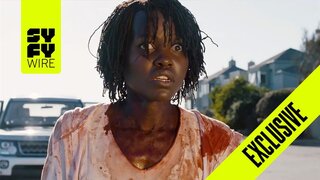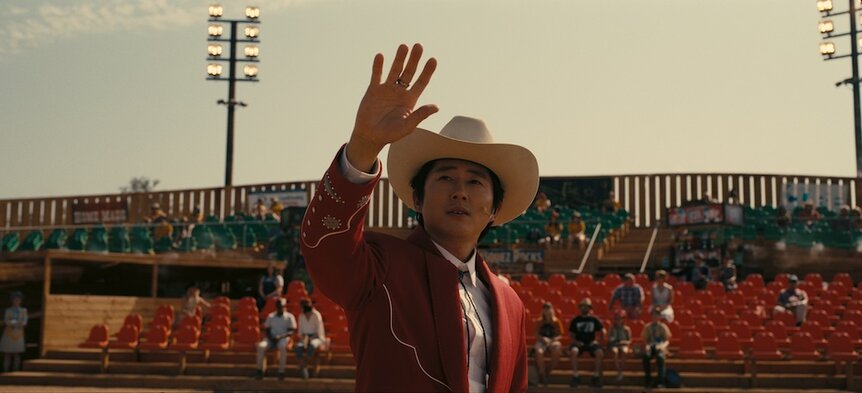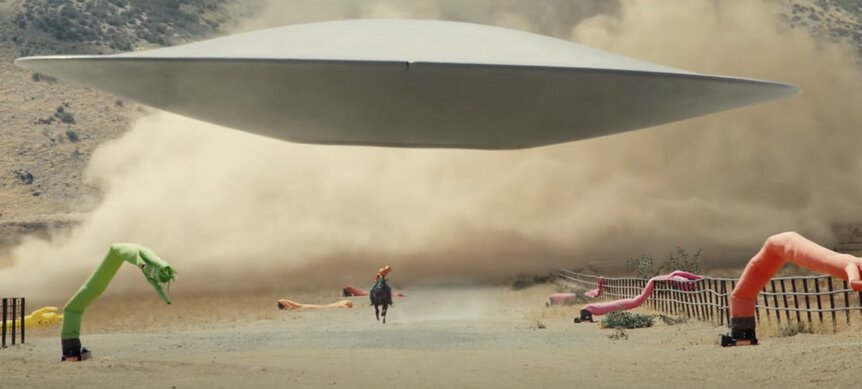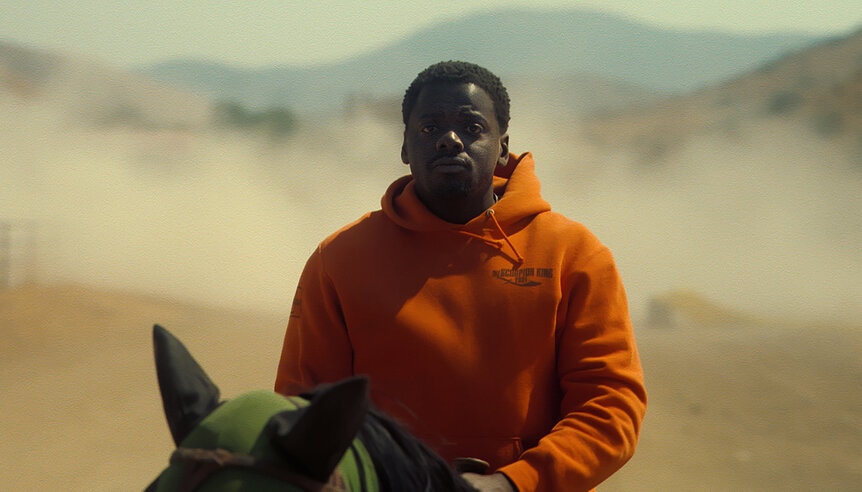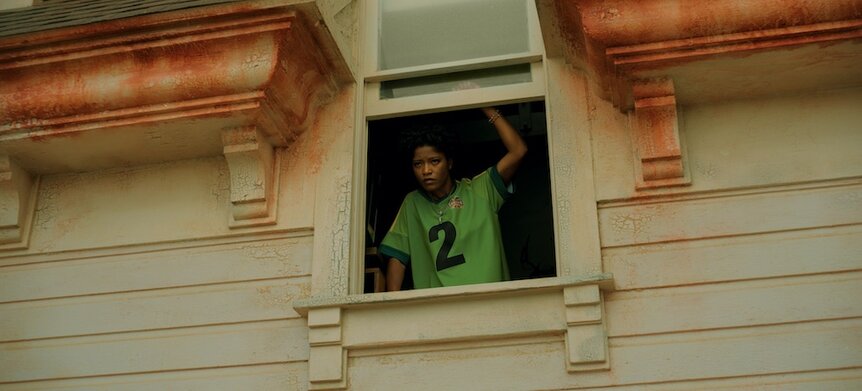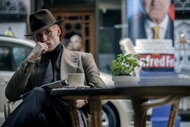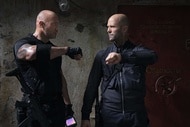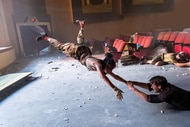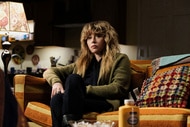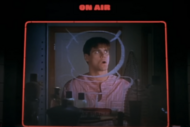Create a free profile to get unlimited access to exclusive videos, sweepstakes, and more!
How Jordan Peele's UFO thriller Nope Drew From '80s Classics Like The Goonies & Gremlins
"I felt like it could be very kaleidoscopic in the world-building and colorful ... I wanted to help create something [that was] visually arresting."
It should come as no surprise to anyone that Jordan Peele is a big fan of the classics. The writer-director's latest genre effort — Nope (now streaming on Peacock) — wastes no time in tipping its Stetson hat to the most influential blockbuster filmmaker of all time, Steven Spielberg, whose silver screen treatment of alien visitation in Close Encounters of the Third Kind and E.T. redefined the way we look up at the night sky, pondering our place in the wider universe.
Nope flips that notion of awestruck wonder on its head with the tale of a sinister presence lurking in the clouds above a remote California desert town, where a pair of siblings, Otis "OJ" Jr., and Emerald Haywood (played by Daniel Kaluuya and Keke Palmer), hatch a gonzo plan to film the unknown entity in the hopes of gaining fame and fortune when their Hollywood horse-training business threatens to go bankrupt. It's part Jaws and part Close Encounters.
A biting, meta critique on the shallow and exclusory nature of the entertainment industry, as well as humanity's stomach-turning desire for morbid spectacle, the film (originally titled Little Green Men) also serves as an unabashed love letter to culturally significant genre movies of yesteryear. This paradoxical desire to satirize Hollywood, while paying deference to its cultural impact at the same time, infused itself into every aspect of production, including the costumes designed by Emmy nominee, Alex Bovaird (Bad Education, Sorry for Your Loss, The White Lotus).
How Classic '80s Movies Inspired The Costumes of Nope
"In one way, it's very straightforward: good guys [and] bad guys chasing the alien; the alien chases them, trying to get the shot. And in other ways, it's very ponderous and kind of puzzling," she explains during a Zoom conversation with SYFY WIRE. "It just had a lot to it and I felt like it could be very kaleidoscopic in the world-building and colorful ... I wanted to help create something [that was] visually arresting."
Bovaird fully embraced the project's oxymoronic philosophy with a visual aesthetic directly inspired by the past.
"The first thing that I thought about this movie, in terms of an overall feel for the characters, was The Goonies," she says of the 1985 adventure flick conceived and executive-produced by Spielberg. "We always had that big ‘80s movie in mind. If you look at movies like The Goonies, or Gremlins, or that whole era [of blockbusters], the costumes are quite strong — not in a distracting way, but there are definitely some strong colors. [The characters] would stay in certain costumes for a long time. I remember looking at The Goonies and thinking, ‘Well, there’s a lot of yellow and reds.' We went for a bit more of a rainbow color palette in the end, but we definitely kept that in mind."
The ultimate goal, Bovaird explains, was to "create iconic looks" akin to Michael J. Fox's famous wardrobe of jeans, sneakers, denim jacket, and puffy orange vest Back to the Future. "I suppose every costume designer is trying to do that, but we we wanted this big, bold, bright Goonies-esque ensemble," the costume designer adds. "There was a lot of riffing. In the art department and the costumes, [we were] sort aping certain things, for sure."
For More on Jordan Peele:
Wes Craven Classic The People Under The Stairs Headed For Reboot From Jordan Peele
Jordan Peele Explains the Nope Chimp Scene
How Get Out Kickstarted Jordan Peele’s Scary Great Horror Career
Prior to boarding the film, Bovaird found herself entranced by a curious art installation in the middle of Joshua Tree National Park. "I just came across a big cube of earth with clothes shoved into it and then more earth [and] more clothes. I could see how cool bright colors looked with earth," she recalls. Funnily enough, this bizarre amalgam of organic and inorganic materials would play out in the movie as the alien creature sucks up people and horses before spitting out the things (keys, pocket change, etc.) it cannot digest.
"I took a picture of it and that was my palette. I also liked the way it looked like Earth's detritus, just spat out onto this beautiful landscape. I think that is one of the themes [of the movie]. That was the vocabulary: bright, poppy, commercial influences that have just been squashed onto the land."
She credits Peele's background in improvisational comedy with helping facilitate a more fruitful creative process:
"I feel like he's always workshopping ideas. It’s a very exciting collaborative process, but one in which you kind of have to jump into and be taken on the ride. Just when you've sort of figured something out, you're like, ‘Oh, well, let's try this,’ or ‘Let's try and make this even better.’ [Peele and fellow producer, Ian Cooper are] always trying to get better, and they’re always coming in with other ideas ... I would present certain strong ideas and then they would sort of move on. And then sometimes, they’d come back around to what I had thought, or sometimes, they’d be completely disagreed with. It was a brilliant costume carousel."
Inside Jupiter's Claim
The ostentatious get-up of Ricky "Jupe" Park (Steven Yeun), a former child star and current operator of the cheesy Jupiter's Claim theme park, who foolishly believes he can exploit the alien being for profit on a weekly basis, made for one of the most iconic looks. According to Bovaird, The Goonies star Corey Feldman was considered for the part at one point before Yeun's casting. While Peele originally wanted Jupe to "play it down," Bovaird talked him into the idea of using "really loud colors" that represented the thematic hollowness of pageantry.
"We were playing with the idea that Jupe is still obsessed with artifice," she continues. "He's a failed child actor, so he's still trying to get attention and he doesn't know who he is. We liked the idea that the clothes that you see him wear … are, in effect, costumes. Steven Yuen and I talked about just slightly leaning into this Willy Wonka thing. He’s in his rinky-dink theme park, and he still is the star of the show. It’s this way to find his way back from being a failed actor."
Bovaird says building the hokeyness of Jupiter's Claim was among her favorite duties, "because you can kind of go for it, creating a theme park and staff uniform. There's tons of stuff we worked on that you don't even really see, but the little textures of everything in there. Every staff member has a story and every staff member has different swag — different buttons and socks, and their own little character. They have different bucket hats, and they have stripes on their sleeves, according to some sort of stripe path that they get from working at Jupiter's Claim. There’s a whole world that we created that you can't even really see. It's just what you do sometimes in movies when you have these big worlds."
Based on the gaudy and rhinestone-studded rodeo suits popularized by rodeo tailor Nudie Cohn, Jupe's costume was devised as "a subversion of American iconography, but with an Asian guy playing it instead of a white guy," Bovaird says. "We had some crazier versions — there was a pink suit with leather fringe that we tried. We weren't going to do embroidery in the back at one point, but it looked like something was missing. I think Jordan was nervous that it would look too Vegas. We had embroidery on the front, and it just looked like we'd forgotten the back. So I'm so glad we did that because that was really cool to see the back of that."
The inclusion of Canyon Snow Irises on the back of Jupe's jacket foreshadows the monster's final form in the third act. While no concrete explanation on the origin of the UFO-like creature is ever provided, Peele apparently referenced everything from "jellyfish" to "flowers," Bovaird reveals. "[He was] always talking about some sort of organic thing. Membrane-y." Whatever the thing is, it considers the Haywood Ranch (inherited by OJ and Emerald after the mysterious death of their father) as part of its territory.
Why It Was So Hard to Get That Scorpion King Sweatshirt Right
Descended from the jockey depicted in what is considered to be the very first motion picture — Eadweard Muybridge's Horse in Motion — the Haywood siblings could not be more different in dress or personality.
OJ, who suffers a major loss of confidence after losing his father, "doesn't really think about his clothes," Bovaird says. "They're like whatever he has [on hand]. His clothes are made up of a lot of movie swag. When you work on movies, you're often given a crew T-shirt or a sweatshirt, So he has a few of those. He wears a T-shirt that we made that was invented by a grip company that he was given for a movie. He [also] wears a Mario's Catering T-shirt. He wears a lot of his own logo stuff. Sometimes, these animal wranglers just come to work in a T-Shirt that says their company on it and we thought about a way to mix Western with casual wear for both [OJ and Emerald]. OJ does it in a bit more thoughtless way."
His signature article of clothing, a bright-orange hoodie inspired by a shirt given to the crew of 2002's The Scorpion King, turned out to be one of the hardest costume nuts to crack. "I find when it's something as simple as a T-shirt or a hoodie, people can get really crazy about the fit of the hoodie or the the aging on the hoodie," Bovaird admits. "We had to have 10 hoodies, and they had to be aged exactly the same. And sometimes, we would sort of f*** one up a bit because we'd go too far, or we did some printing and it didn't work. And then Daniel wanted two different hoodies ... so, we had to have 40 versions of two hoodies."
Emerald, on the other hand, is much more outgoing, vivacious, and a little reckless, constantly rocking "outfits that are mixing bright, poppy, oversized T-Shirts, but with cowboy boots, Western belts, and leather vests," Bovaird adds. "We like putting stories into why they end up wearing what they're wearing. There's a lot of backstory with Emerald that wasn't necessarily shown, where she's kind of drifting and hasn't really found her purpose. She also takes things from people that she’s staying with, so her costumes are supposed to be just a mix of things."
Otis Sr. briefly appears at the start of the film, where he's played by the legendary Keith David, whose casting may be a subtle nod to a pair of John Carpenter-directed alien invasion classics: The Thing and They Live. "We wanted him to look like a classic cowboy," the costume designer says. "Real ranchers all wear cowboy boots, Wranglers, belts, and button shirts. We were taking artistic license with OJ not wearing that, but there was no doubt that Otis Sr. would be wearing the classic cowboy look."
OJ and Emerald receive unexpected help in their mission to record the alien from the tech-savvy Angel (Brandon Perea), a third-wheeling employee of Fry's Electronics, who provides a great deal of comedic relief.
"We were trying to play off Brandon's sort of natural effervescence because we wanted him to be a bit more cynical and over it all," states Bovaird. "He gets excited once he starts getting in the whole alien-hunting game, but certainly when we meet him, we wanted to present him as this nerdy [guy] listening to slightly obscure bands. So he wears a lot of band T-shirts, black cut-offs, and Vans. We're in California, so we always tried to keep all of them realistic to how people in California dress. But yeah, we thought a lot about his band T-shirts and just tried to keep him nerdy and cynical."
The Captain Quint of the cosmic expedition is Antlers Holst (Michael Wincott), a veteran and gravelly-voiced cinematographer chasing the most impossible shot of his entire career. Wincott insisted on wearing all black, which worried Bovaird, given the sweltering backdrop against which Nope filmed most of its action.
"I definitely pushed back a little bit because I was worried about his comfort," she explains. "[The shoot] was out in Santa Clarita canyon country, it's like 115 degrees, there was no shade, and [we had] these endless action sequences. But he was adamant that he wanted to wear black. And then he met our cinematographer, Hoyte [van Hoytema], who only wears black, and also wears a black wool scarf. So I couldn't really win that argument anymore. I guess some people just don't really get hot. But I've worked with a lot of actors, and I don't want them to commit to this one costume and then be uncomfortable. Michael and I actually went shopping together for his costume. We had a lot of fun."
Gordy's Home
Of course, no discussion on Nope would be complete without a mention of Gordy's Home, the apocryphal '90s sitcom that captivated American audiences until its titular star, a seemingly trained chimpanzee (brought to life via a motion capture performance by Terry Notary), went on a bloody rampage, mutilating and/or killing members of the cast.
The made-up TV show factors heavily into Jupe's backstory; he was one of its actors and bore witness to the ape's horrific display of violence — an experience that left the boy with a serious amount of trauma and the misguided delusion that he somehow has the power to control the lawless beings of nature. For this retro flashback, Bovaird found herself drawn to the usual '90s-era suspects — Full House, Family Matters, ALF — and one obscure sitcom, Unhappily Ever After, in which Bobcat Goldthwaite voices a talking stuffed bunny rabbit. "It's really fun doing these things because you kind of go down the rabbit hole and find these really strange pop culture phenomenons," she says.
Jupe's unresolved emotional scarring manifests itself in an alien design (one that vaguely recalls the eponymous creature in 1953's Robot Monster) the wannabe tycoon has commoditized at Jupiter's Claim. This imagined species leads to a memorable fake-out, in which Park's children dress up in alien costumes to prank the Haywoods.
"There were so many iterations of them. We kind of knew that we wanted to create something that was uncanny. So [it turned out to be] this mixture of latex and fur, which could be done really badly. We tried to sort of do it well, but [also] badly to make it uncanny," Bovaird concludes. "At first, [Jordan] liked the idea of it looking like Gordy a little bit; that subconsciously, the aliens that Jupe created were little chimps. And then the other version was the latex version. Then Jordan was like, ‘Well, maybe we can do latex and fur.’ At first, I was like, ‘Oh, that's gonna look terrible,’ but we worked on it and worked on it and worked on it and came up with that … [Jordan and Ian are] always riffing on these weird episodes of The Twilight Zone or these B-movies. Even with the design of the alien and some of the effects, even though they were rendered incredibly well, I feel like there's a little bit of that B-movie history coming at you. And with the little monsters, too...going for creepy rather than realistic."
Nope is currently streaming on Peacock.
Originally published Jul 26, 2022.
